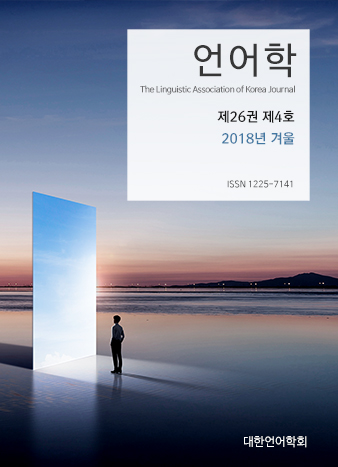대한언어학회 전자저널

-
L1 Interference in Koreans' Perception of Released Word-final Stops in English
-
Perceptual Similarity between English and Korean: Evidence from Online Adaptation
-
A Study on the Definite Article in English Based on the Rasch Model
-
Phonetic Resurrection from Ellipsis Sites: A Case from Pseudo-gapping
-
A Study of the Content Validity of Reading Comprehension Tests in NMET II
-
Labeling, Cartography, and the Left-periphery of Korean Clauses
26권 4호 (2018년 12월)
- Perceptual Similarity between English and Korean: Evidence from Online Adaptation
-
Jungyeon Kim
Pages : 21-35
Abstract
Keywords
# stop release # final stress # perceptual similarity # similarity judgments
References
- Bates, D., Maechler, M., Bolker, B., & Walker, S. (2015). Fitting linear mixed-effects models using lme4. Journal of Statistical Software, 67(1), 1-48.
- Boersma, P., & Hamann, S. (2009). Loanword adaptation as first-language phonological perception. In A. Calabrese & W. L. Wetzels (Eds.), Loanword phonology (pp. 11-58). Amsterdam/ Philadelphia: John Benjamins Publishing Company.
- Boomershine, A., Currie Hall, K., Hume, E., & Johnson, K. (2008). The impact of allophony versus contrast on speech perception. In P. Avery, B. E. Dresher, & K. Rice (Eds.), Contrast in phonology: Theory, perception, acquisition, volume 13 of Phonology & Phonetics (pp. 145-171). Mouton de Gruyter.
- Broselow, E. (2009). Stress adaptation in loanword phonology: perception and learnability. In P. Boersma & S. Hamann (Eds.), Phonology in perception (pp. 191-234). Berlin and New York: Mouton de Gruyter.
- Byrd, D. (1992). A note on English sentence-final stops. UCLA Working Papers in Phonetics, 81, 37-38.
- Crystal, T., & House, A. (1988). The duration of American-English stop consonants: an overview. Journal of Phonetics, 16, 285-294.
- de Jong, K., & Park, H. (2012). Vowel epenthesis and segment identity in Korean learners of English. Studies in Second Language Acquisition, 34, 127-155.
- Dupoux, E., Kakehi, K., Hirose, Y., Pallier, C., & Mehler, J. (1999). Epenthetic vowels in Japanese: A perceptual illusion? Journal of Experimental Psychology: Human Perception and Performance, 25, 1568-1578.
- Hothorn, T., Bretz, R., & Westfall, P. (2008). Simultaneous inference in general parametric models. Biometrical Journal, 50(3), 346-363.
- Jun, E. (2002). Yeongeo chayongeo eumjeol mal pyeswaeeumui payeol yeobuwa moeum sabibe gwanhan silheomjeok yeongu (‘An experimental study of the effect of release of English syllable final stops on vowel epenthesis in English loanwords’). Eumseong eumun hyeongtaeron yeongu (‘Studies in Phonetics, Phonology and Morphology’), 8, 117-134.
- Jun, S.-A., & Beckman, M. (1994). Distribution of devoiced high vowels in Korean. Proceedings of the International Conference on Spoken Language Processing, Volume 2, 479-482.
- Kang, Y. (2003). Perceptual similarity in loanword adaptation: English postvocalic word-final stops in Korean. Phonology, 20, 219-273.
- Kwon, H. (2017). Language experience, speech perception and loanword adaptation: variable adaptation of English word-final plosives into Korean. Journal of Phonetics, 60, 1-19.
- Kwon, H., Chitoran, I., Pouplier, M., Lentz, T., & Hoole, P. (2016). Cross-linguistic differences in articulatory timing lag in consonant cluster perception. The Journal of the Acoustical Society of Amercia, 140, 3217-3217.
- Parker, F. (1977). Perceptual cues and phonological change. Journal of Phonetics, 5, 97-105.
- Pegg, J., & Werker, J. F. (1997). Adult and infant perception of two English phones. The Journal of the Acoustical Society of America, 102, 3742-3753.
- Peperkamp, S. (2005). A psycholinguistic theory of loanword adaptation. In M. Ettlinger, N. Fleischer, & M. Park-Doob (Eds.), Proceedings of the 30th Annual Meeting of the Berkeley Linguistics Society, 30 (pp. 341-352). Berkeley: Berkeley Linguistic Society.
- R Core Team. (2018). R: A language and environment for statistical computing. Vienna, Austria: the R Foundation for Statistical Computing.
- Repp, B., Milburn, C., & Ashkenas, J. (1983). Duplex perception: confirmation of fusion. Perception and Psychophysics, 33(4), 333-337.
- Rhee, S.-J., & Choi, Y.-K. (2001). Yeongeo chayongeoui moeum sabibe daehan tonggyegwanchalgwa geu uiui (‘A statistical observation of vowel insertion in English loanwords in Korean and its significance’). Eumseong eumun hyeongtaeron yeongu (‘Studies in Phonetics, Phonology and Morphology’), 7, 153-176.
- Silverman, D. (1992). Multiple scansions in loanword phonology: evidence from Cantonese. Phonology, 9, 289-328.
- Sohn, H.-M. (1999). The Korean Language. Cambridge University Press.
- Steriade, D. (2001). Directional asymmetries in place assimilation: A perceptual account. In E. Hume & K. Johnson (Eds.), The role of speech perception in phonology (pp. 219-250). San Diego: Academic Press.
- Whalen, D., Best, C., & Irwin, J. (1997). Lexical effects in the perception and production of American English /p/ allophones. Journal of Phonetics, 25, 501-528.